To Contact Me


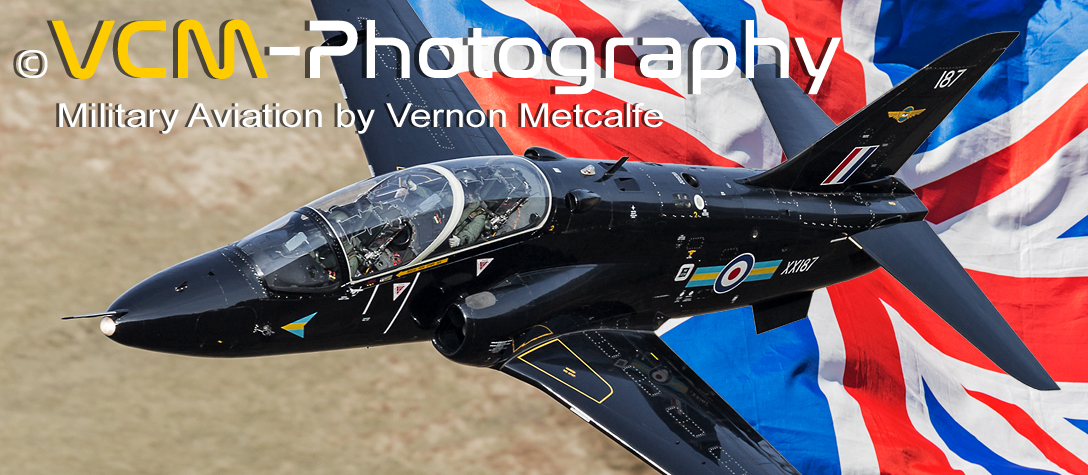
A brief description of former military aircraft photographed in the United Kingdom Low Flying System from 2009 to 2019.
Originally based at Linton-on-Ouse in Yorkshire, the two‑seat Tucano T.1 was introduced into service with the RAF in 1989,
replacing the BAC Jet Provost as a basic fast‑jet trainer, preparing students for progression onto the BAE Hawk T.1/T.2.
The RAF Tucano T.1 was a modified version of the Brazilian Embraer EMB‑312 Tucano, built under licence by Shorts of Belfast.
The original PT6 engine had been replaced with a Garret TPE 331‑12B turboprop engine, with a four‑blade propellor giving
a 50% increase in power and coupled with an Electronic Engine Controller (EEC) system, greatly improved fuel efficiency.
The aircraft also had a revised canopy, designed to be bird strike resistant up to 270 knots (311mph or 500km/h).
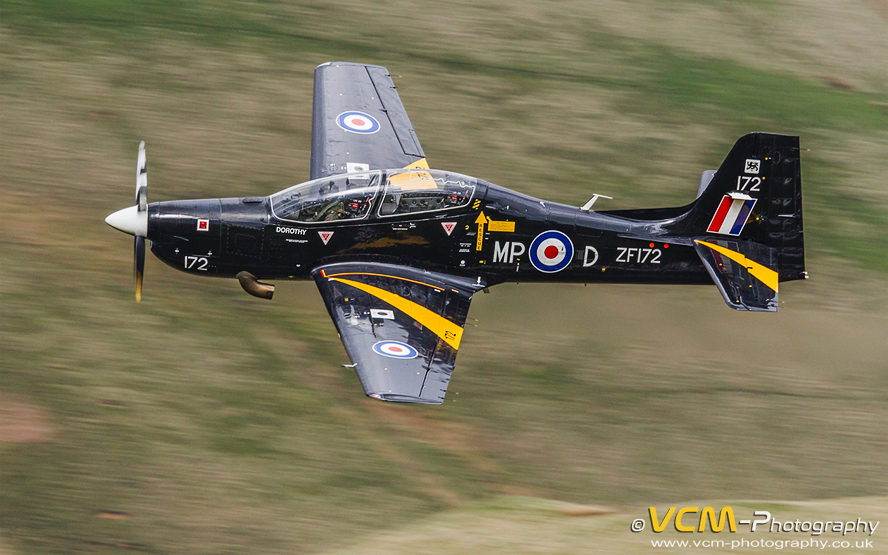
The crew being seated in tandem on Martin‑Baker ejection seats, with a cockpit layout similar to the BAE Hawk, made the Tucano an
ideal training aircraft for future fast‑jet students. Being fully aerobatic and having similar handling characteristics to that
of a jet, the aircraft was used to train students in all aspects of military flying, such as general aircraft handling, formation
flying and low‑level navigation. In addition the aircraft could be flown in all types of weather, day or night.
The Tucano had a maximum speed of 300 knots (345mph or 556km/h) and an ability to maintain 270 knots (310mph or 500km/h)
at low‑level. The aircraft could operate up to 25,000ft (7,620m) with an initial climb rate of 3,270ft (997m) per minute at
sea level. Coupled with good fuel efficiency and lower operating costs than its predecessor the Jet Provost, the Tucano allowed low‑level
sorties to be flown from Linton‑on‑Ouse, their home base, to locations as far away as Wales and the North of Scotland.
In October 2019, the Tucano was retired from its training role in the RAF and replaced by the Beechcraft T‑6 Texan II. In addition the
Basic Fast‑Jet Training (BFJT) course based at Linton‑on‑Ouse was moved to RAF Valley, Anglesey, the home of the Advanced
Fast‑Jet Training (AFJT) course which operates the BAE Hawk T2.
The Hawk T.1 (HS-1182) first flew in 1974 and entered service with the RAF in 1976. Originally designed and manufactured by Hawker Siddeley, over one thousand Hawk aircraft of differing variants have been produced to‑date under the successive companies of British Aerospace and BAE Systems respectively. The aircraft has been exported to numerous air forces around the world, as a training and low‑cost combat aircraft.
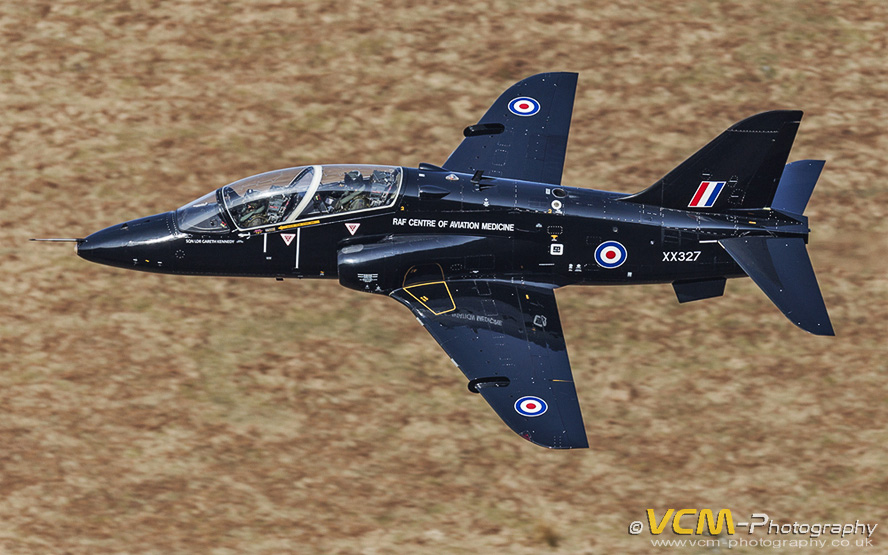
Designed specifically as a training aircraft, the Hawk T.1 took on the role of an avanced flying trainer in the RAF and the
T.1A (modified T.1) as a weapons training aircraft, replacing the Folland Gnat and Hawker Hunter respectively.
Constructed of an all-metal airframe, with a low mounted cantilever wing and one-piece all moving tailplane, the Hawk is a
highly manoeuvrable and agile aircraft. Powered by a Rolls-Royce Turbomeca Ardour 151 turbofan engine, an un‑reheated version
of the engine that powered the SEPECAT Jaguar GR.3, the Hawk can achieve Mach 0.88 in level flight and Mach 1.15 in a dive. The crew
are seated on Martin‑Baker zero‑zero ejection seats in a tandem cockpit, with the instructor in the rear having good forward
visibility (unlike in the Gnat), due to the rear section of the cockpit being elevated over the student in the front.
The Hawk T.1A was used in the RAF for weapons and tactical training, being modified to carry two underwing AIM‑9L Sidewinder
air‑to‑air missiles and a 30mm Aden cannon on a centreline pod, but this role has since been transferred to the T.2.
The T.1A is currently used by the RAF Red Arrows aerobatic display team based at RAF Scampton, Lincolnshire and RAF No. 100
Squadron based at RAF Leeming, Yorkshire. The main task of the latter amongst many, is to provide operational support for frontline squadrons
flying Typhoon and support‑flying for the Joint Forward Air Controllers Training and Standards Unit (JFACTSU) and Close Air
Support (CAS) missions.
The Hawk T.1 is expected to remain in service with RAF No. 100 Squadron till 2027.
The King Air B200 was a variant of the Beechcraft line of twin‑turboprop utility aircraft used extensively by foreign military and civilian operators. The aircraft entered service with the RAF in 2004 with No. 45(R) Squadron, a part of No. 3 Flying Training School at Cranwell, Licolnshire, replacing its fleet of Scottish Aviation Jetstream T.1's. (Note: In 2006, No. 45 Squadrons reserve status was removed. Re‑designated as No. 45 Squadron).
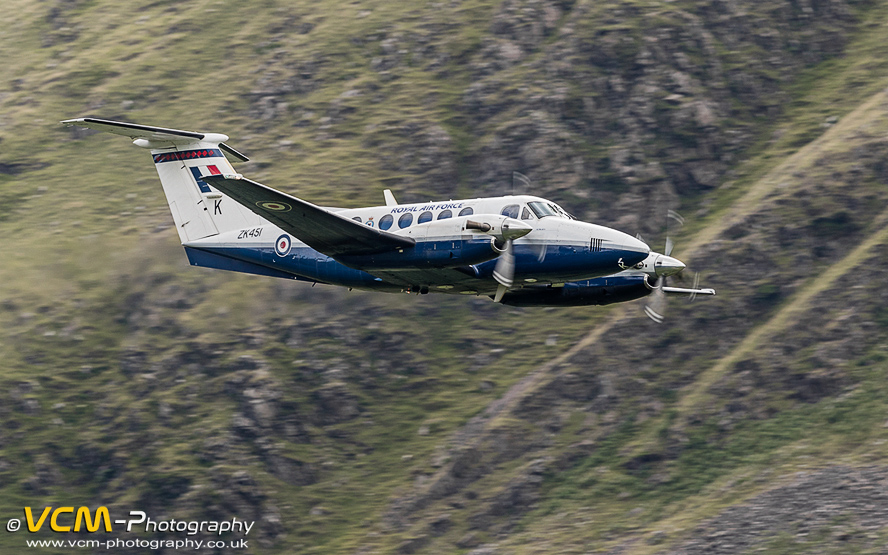
The twin‑engine turboprop monoplane was used as an advanced multi‑engine pilot trainer on which students learned the essential
skills of general handling, asymmetric flying, emergency handling and radio‑aids navigation. The aircraft was also used for pilots working
towards captaincy and for advanced skills such as formation flying and low‑level flying.
The B200 was powered by two Pratt & Whitney PT6A‑42 turboprop engines, each producing 850shp. The aircraft had a maximum speed
of 259 knots (298mph or 480km/h) and was cleared to fly to 35,000ft (10,668m) though RAF regulations restricted it to
28,000ft (8,534m).
In 2008 the RAF added the B200GT model to its fleet, which came with a fully electronic glass cockpit, new Pratt & Whitney PT6A‑52
engines which provided higher cruise speeds and faster climb rates.
The King Air which provided the RAF with a high performance aircraft at low operating costs was eventually retired from its role in 2018,
to be replaced by the Phenom T.1.
The maiden flight of the first Domine, registration XS709 took place on 30th December 1964. The aircraft was the RAF military version of the Hawker Siddeley HS.125 twin‑engine, mid‑size executive jet (later called the Bae 125 when in 1977 Hawker Siddeley merged with British Aircraft Corporation to form British Aerospace).
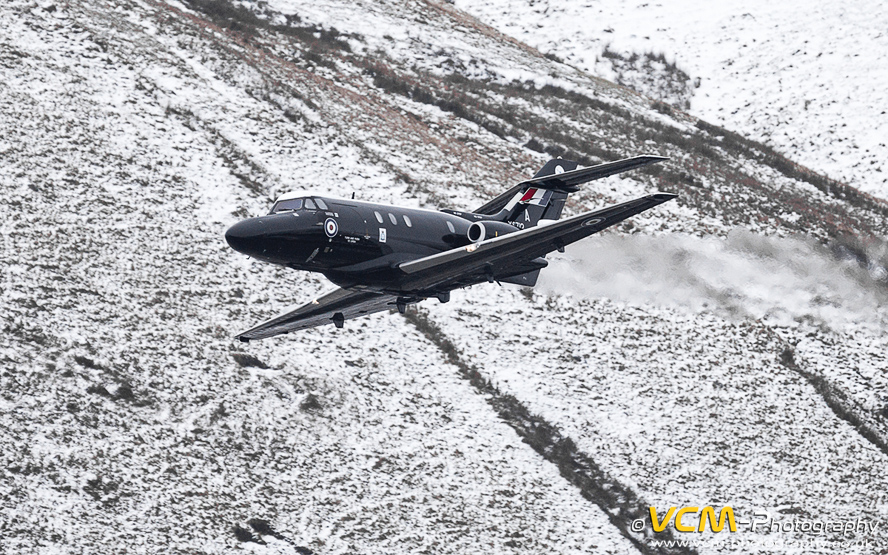
The Dominie had a modified airframe and was powered by two Rolls‑Royce Viper 301 turbojets, each producing 3,000lbs thrust.
With a typical crew of six, consisting of one pilot (Captain) and a combination of five students and instructors it was an ideal aircraft
for the RAF to train its Navigators, Weapon Systems Operators and Air Engineers. The Dominie replaced the Varsity and Meteor in the training of
fast‑jet navigators, but as it was the time of the Cold War most of the training took place in the high speed/high altitude environment
where the V force operated.
In 1992 (with the end of the Cold War in 1991) the Dominie had a major upgrade, replacing outdated V force technology with equipment more suited
for the RAF's fast‑jet fleet. In 1996, more upgrades followed with the installation of new avionics and systems, which included a ground mapping
radar and navigational mission computer.
With the cancellation of the Nimrod MRA.4 in 2010 and the drawdown of the Tornado GR.4 fleet and the future of fast‑jet WSO's not required, the
decision was taken to retire the Dominie. On the 20th January 2011, RAF No. 55(R) Squadron, part of No. 3 Flight Training School who had operated
the Dominie since 1966 retired its aircraft from service.
The Hercules is a four‑engine turboprop, designed and built by Lockheed (now Lockheed Martin) as a troop, medevac and cargo/ transport aircraft. Its rugged design and short take‑off and landing capabilities, allows it to be operated from unprepared/semi‑prepared surfaces by day or night.

The strength of the airframe has allowed the aircraft to be adapted for alternative roles, such as air‑to‑air refuelling, weather
recconaissance, aerial firefighting, scientific research, military gunship, airborne assault and search and rescue roles.
The first production C‑130A Hercules entered service with the USAF in December 1956. The first RAF Hercules entered service in 1967, as a
replacement for the ageing piston engine fleet of Blackburn Beverley and Handley Page Hastings aircraft. Sixty‑six aircraft were ordered and
designated as C‑130K C.1 models, which were based on the American C‑130E model. A 15ft stretched fuselage version of the C‑130K C.1
was introduced in 1979. This allowed twenty‑six extra parachutists or two extra cargo pallets to be carried and was designated
as the C‑130K C.3.
The RAF Hercules served in the 1982 Falklands War and due to the distances involved with flying from Ascension Island to the Falklands, in‑flight
refuelling probes were fitted. The aircraft were designated C‑130K Mk. 1P models. Some aircraft were later converted into tankers, by
installing hose and drum units (HDU‘s) and refuelling probes, to support the RAF Harrier and Phantom in the islands air defence role.
The Hercules ‘K’ model had a crew of five (Pilot, Co‑Pilot, Navigator, Flight Engineer and Loadmaster) and was powered
by four Allison T‑56‑A‑15 four‑blade turboprops, providing a cruising speed of 325 knots (374mph or 602km/h)
and a full payload range of 2,047 nautical miles (2,356 miles or 3,791km) and an empty range of 4,522 nautical miles
(5,204 miles or 8,375km).
In November 1999 the RAF received its first batch of a new generation Hercules, the C‑130J, which came with refueling probes fitted as standard
and a reduced aircrew of two Pilots and one Weapons Systems Operator/Loadmaster.
C‑130J Mk. C.5 is the standard‑length model (97ft 9in/29.79m).
C‑130J Mk. C.4 a stretched version (112ft 9in/34.34m).
New more powerful Allison engines with six‑blade composite propellors gave improved engine performance, with the aircraft requiring shorter
take‑off runs and better fuel efficiency negating the need for external underwing fuel tanks as on the K‑models. Other improvements apart
from lower operating and maintenance costs, include a new digital glass cockpit with head‑up display (HUD),
4 x multifunction LCD displays, traffic collision avoidance system and compatible night vision goggles (NVG's).
The C‑130J has a crusing speed of 320 knots (368mph or 593km/h).
Ferry range for the Mk. C.4 is 2,650 nautical miles (3,050 miles or 4,908km),
Ferry range for the Mk. C5 is 2,850nm (3,280 miles or 5,078km),
Both models have a cruising altitude of 28,000ft (8,534m) and maximum altitude of 40,000ft (12,192m).
The Hercules since entering service with the RAF has been involved in ongoing World conflicts, such as the Gulf Wars, the Balkans, Afghanistan,
Iraq and Libya. The RAF ‘K’ model aircraft were retired in October 2013 after fifty years of continuous service. The ‘J’ model
is destined for withdrawal in 2022, apart from fourteen aircraft which will remain in service till 2030 working alongside the A400M Atlas.
The Tornado GR.4, ‘Tonka’ or ‘Big Fin’ as it was nicknamed by aviation enthusiasts and aircrew alike, was a supersonic
two‑seat, twin‑engine, variable‑sweep wing combat aircraft, primarily used in the ground‑attack and reconnaissance role,
being able to fly at low‑level in all weather, day and night.
The aircraft was developed and manufactured by Panavia GmbH, a consortium of BAE Systems (formerly British Aerospace) of the U.K.,
MBB (formerly EADS) of West Germany and Alenia Aeronautica (formerly Aeritalia) of Italy.
Three Tornado variants were developed. The IDS (interdictor/strike) fighter‑bomber, the Tornado ECR (electronic combat/
reconnaissance) to suppress enemy air defences and the Tornado ADV (air defence variant) interceptor aircraft, with certain variants
being operated by the Royal Air Force, German Air Force, Italian Air Force and the Royal Saudi Air Force.
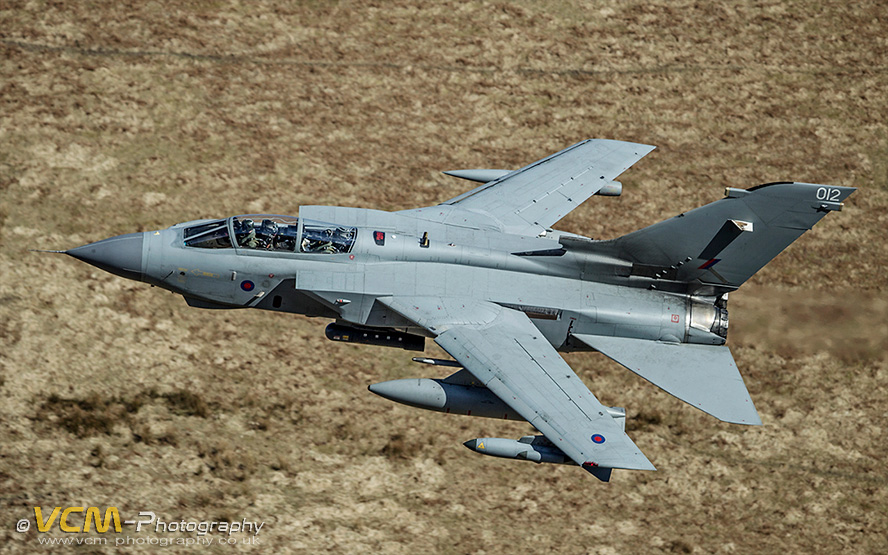
The Tornado or Multirole Combat Aircraft (MRCA) as it was formerly known, first flew in 1974 and was introduced into service
in 1979/1980. The Tornado entered service with RAF as the GR.1 model. The aircraft had high/low speed handling characteristics enabled
by a variable‑sweep wing (swing‑wing), a tried and tested design used by the American Grumman F‑14 Tomcat and
General Dynamics F‑111 Aardvark. The wing could adopt a sweep angle between 25 degrees to 67 degrees depending on the aircraft speed.
The 25‑degree sweep enabled the aircraft to fly relatively slower giving more lift, while the 67‑degree sweep allowed high speed
flight, due to increased streamlining and reduced drag.
The aircraft had a short take‑off and landing (STOL) performance, enabled by full span flaps and leading‑edge slats which gave
good low speed handling characteristics. Thrust reverser‑equipped engines helped reduce roll‑off distance after touchdown.
The Turbo‑Union (joint venture by Fiat, MTU and Rolls‑Royce) RB.199 Mk. 103 afterburning turbofan engines, equipped with a
Digital Engine Control Unit (DECU) gave the aircraft a maximum speed of Mach 1.3 and ceiling of 50,000ft (15,240m), from
an engine which was extremely compact, requiring a small airframe design.
Flying control was primarily fly‑by‑wire, with a mechanical reversion capacity retained to safeguard against potential failure.
Terrain following radar for low‑level flying gave the Tornado the ability to fly in this environment in all weather, day or night, with the
pilot in hands‑off the controls mode.
The GR.4 was a modified version/mid‑life upgrade of the GR.1. Its first flight was in April 1997, with deliveries to the RAF taking
place between 1997 to 2003. Upgrades included forward looking infrared, wide‑angle head‑up display (HUD), improved
cockpit displays, night vision goggles (NVG) capability, new avionics and GPS receiver. The GR.4 was armed with ASRAAM (high speed,
highly manoueuvrable heat seeking air‑to‑air missiles) for self‑defence and a single internal 20mm Mauser cannon for
ground support. Extra fuel could be carried in 1,500 litre and/or 2,250 litre drop tanks, as well as the ability to conduct
air‑to‑air refueling. The aircraft also had the capability to carry ‘Raptor’ reconnaissance pods and deploy
‘Storm Shadow’ cruise missiles, ‘Brimstone’ anti‑tank missiles and ‘Paveway IV’
GPS/laser‑guided bombs.
During it's operational service in the RAF, the Tornado GR.4 has been almost continuously involved in world conflicts, from Iraq,
Afghanistan to Libya and recently Syria.
The RAF Tornado GR.4's out‑of‑service date is set for 2019.
Originally designed by Hawker Siddeley Aviation, the single‑seat subsonic Harrier strike attack aircraft first flew on 31st August 1966
and entered service with the RAF in April 1969 as the Harrier GR.1.
Powered by a vectored‑thrust turbofan engine, which can direct its thrust through four rotatable engine exhaust nozzles, the Harrier
could operate without the need for conventional runways. Having vertical short take‑off and landing (VSTOL) capabilities enables
the aircraft to be deployed away from airbases, due to its ability to operate with minimal ground facilities and very short runways.
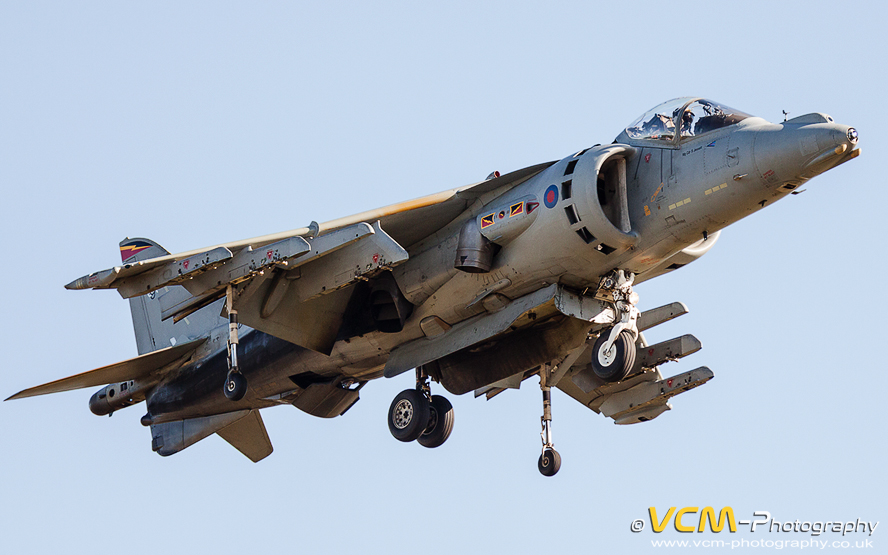
In the early 1970's, Hawker Siddeley entered into a re‑development project of the Harrier (currently the GR.3)
with the American aircraft manufacturer McDonald Douglas, but pulled out due to escalating costs. McDonald Douglas continued with the project,
the end result being the AV‑8 Harrier II.
In the late 1970's, British Aerospace re-entered the project with McDonald Douglas (now part of BAE Systems and Boeing respectively).
The outcome was a British derived version of the AV‑8, the GR.5 Harrier II, which entered service with the RAF in July 1987.
Upgrades and modifications to the GR.5 resulted in the GR.7 and ultimately the GR.9, with the latter entering service with the RAF
in October 2006.
The GR.9 featured an elevated cockpit which provided a better all‑round view. A new fuselage and one‑piece wing constructed of
composite material was stronger and lighter, allowing increased payloads. The aircraft is powered by a Rolls‑Royce Pegasus Mk. 107
VSTOL engine, which provided a high thrust‑to‑weight ratio and retained performance in hot and high‑altitude conditions.
Aircraft fitted with the uprated Mk. 107 engine were designated GR.9A. The GR.9 could deploying a wide range of weapons, from
air‑to‑air, air‑to‑surface missiles and general purpose and precision guided bombs.
The Harrier T.12 is a two‑seat version of the GR.9.
The Harrier was retired prematurely in 2010, because of the Government Strategic Defence and Security Review (SDSR), with the final
operational flights taking place on the 15th December. The aircraft was officially withdrawn from service in March 2011.
The Tornado F.3 Air Defence Variant (ADV) was a long range, two‑seat, twin‑engine, all‑weather interceptor, developed
from the Tornado GR.1 variant, via the eighteen short‑lived Tornado F.2 ADV's. The aircraft was specifically developed for the
Royal Air Force (RAF) in the air defence role, as a beyond visual range interceptor, to replace the Lightning and Phantom.
The variant was also operated by the Royal Saudi and Italian Air Forces.
The F.3 made its maiden flight in November 1985 and was in use by the RAF Operational Conversion Unit (OCU) from July 1986.
The aircraft entered squadron service in April 1987 with RAF No 29 Squadron at Coningsby, which became NATO operational in November
of the same year.
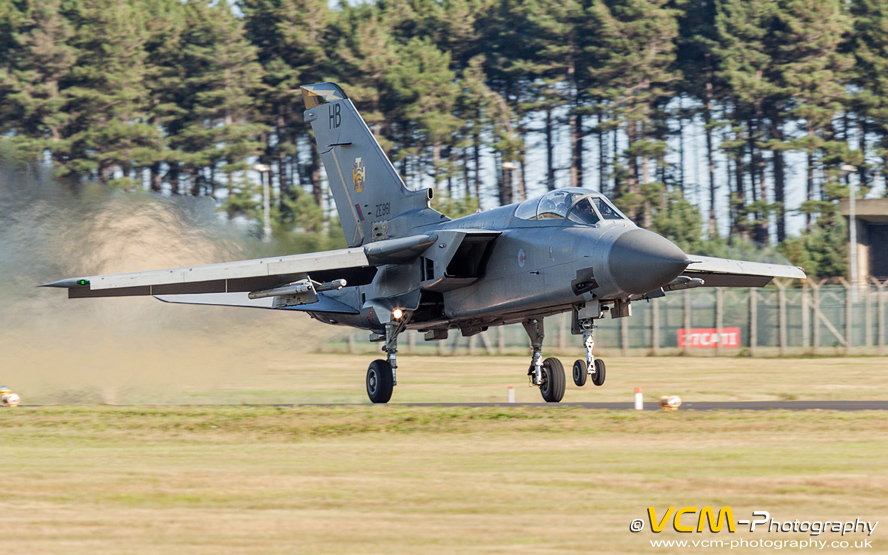
Though similar to the GR.1, the F.3 differed in several areas. The fuselage was stretched by 1.36 metres, which allowed the carriage of
four ‘Skyflash’ medium range air‑to‑air missiles mounted on four semi‑recessed
under‑fueslage hardpoints to reduce drag. Four AIM‑9 ‘Sidewinder’ short range air‑to‑air missiles could be
carried on swivelling underwing hardpoints.
With a longer radome to house the (at‑first troublesome) long range ‘Foxhunter’ radar, the F.3 became a relatively
formidable interceptor. Though it carried a single 27mm Mauser BK‑27 revolver cannon, the F.3 was never intended as a ‘Dogfighter’,
as compared to the more agile American F‑15 Eagle. The stretched fuselage also enabled the addition of a 900 litre fuel tank behind the cockpit.
This coupled with two underwing 2,250 litre drop tanks and an air‑to‑air refuelling capability allowed the F.3 to stay aloft for
long periods maintaining combat patrol.
Powered by two Turbo‑Union RB.199‑34R Mk. 104 engines optimised for high‑altitude use with longer afterburner nozzles,
the F.3 had a maximum speed of Mach 2.2 (1,490mph or 2,398km/h) at 30,000ft (9,144m), or 921mph (1,482km/h)
at near sea level.
The F.3 saw combat in the 1991 Gulf War and afterwards patrolling the Iraq No‑Fly Zone. In 1993 to 1995, the F.3 acted as an escort fighter
over Bosnia and in 1996 flying air combat patrols over Yugoslavia. The F.3 again saw service in 2003 during the invasion of Iraq in
‘Operation Telic’, but was withdrawn due to the absence of any airborne threat.
With the Typhoon taking over the Northern QRA duties, the F.3 was retired from active service on the 22nd March 2011, when RAF No. 111 Squadron
disbanded at RAF Leuchars. The last flights took place on the 9th July 2012, when QinetiQ flew their remaining F.3's to
RAF Leeming for scrapping.
To see a brief description of curent military aircraft photographed in the United Kingdom Low Flying System
please go to page 1.

